Planet of the Vampires (1965)
Directed by: Mario Bava
Written by: Alberto Bevilacqua, Antonio Román, Callisto Cosulich, Ib Melchior, Louis M. Heyward, Mario Bava, Rafael J. Salvia, Renato Pestriniero
Starring: Ángel Aranda, Barry Sullivan, Evi Marandi, Norma Bengell
Italy/ Spain
AKA TERRORE NELLO SPAZIO, TERROR IN SPACE
AVAILABLE ON REGION ‘A’ BLU-RAY AND DVD
RUNING TIME: 87 min/ 85 min
REVIEWED BY: Dr Lenera, Official HCF Critic
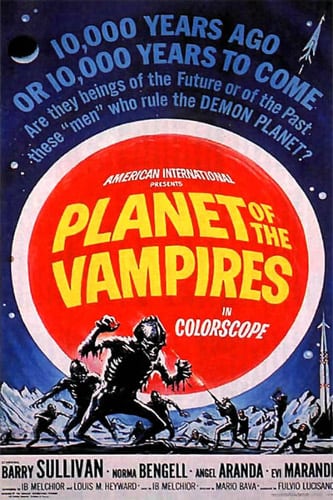
Interplanetary ships the Galliott and the Argo receive a distress signal emanating from Aura, an unexplored planet, and investigate. While entering the planet’s atmosphere, the crew of the Argo becomes possessed by an unknown force and try to violently kill each other. Captain Markary is able to force all of the others aboard his ship out of their murderous state and land. The crew search for the Galliott and find that its crew have killed each other. They proceed to bury as many of the corpses as they can, but several bodies trapped in the ships’s bridge disappear, and, after some of the Argo’s crew are found dead, somebody sees their corpses walking in the ship….
This was one Mario Bava film that – can you believe it – I only saw for the first time the other day, though as I watched the Blu-ray certain bit seemed a bit familiar to me so I actually had seen it, or some of it, a couple of decades or more ago, or seen a similar movie. Planet Of The Vampires, whose title and original American poster are both misleading because there are no vampires in the film [which is actually a scaled down zombie variant on the ever popular Invasion Of The Body Snatchers theme of aliens possessing humans], is a terrific exercise in eerie atmosphere with some moments that even surprised me in how unsettling they were, while also being a fine example of how to create something from extremely limited resources. Saying all that, it doesn’t always have the tension it should have and doesn’t really fulfil its potential [even if one appreciates the tiny budget], so, despite its good reputation, it’s not really a film I would quite place in the top half of Bava’s oeuvre, though being Bava it’s still good and far superior to many similar pictures that came out around the time; the Italians produced many science fiction films, but I don’t think they generally had a knack for them as they did horror films. I have yet to see a film from this extraordinary director that I found to be poor, though granted there is still some work of his have yet to see like the supposedly awful Dr Goldfoot And The ‘S’ Bomb!
This film was the result of a collaboration between American International Pictures, who had distributed some of Bava’s earlier films in the US to considerable commercial success, and Italian International Film, along with some Spanish money from Castilla Cooperativa Cinematográfica. Renato Pestriniero’s short story One Night Of Twenty-One Hours was adapted by Ib Melchior into a screenplay called The Haunted World. Major differences from the filmed script include a romance between Wess and Tiona, Tiona predicting disaster, several races being reanimated and possessed near the end to besiege the Argos’ crew in the climax, and an ending where Wess and Tiona become Adam and Eve on Earth. Once in Italy though, this script was retitled several times [Bava preferred The Shadow World] and rewritten by several other writers, including Bava himself, partly to scale down the story for budgetary reasons, which is similar to what happened to Melchior’s script for Robinson Crusoe On Mars, though Planet Of The Vampires was very low budget indeed, with Bava having to do every effect ‘in-camera’ as there was no money for opticals. The film didn’t even have a female star for two weeks, with the first choice not showing up and the cast having to react to the offscreen script girl. The US version, which was double billed with Die Monster Die, had different opening and closing credits, the characters called different names, and a few scenes edited differently and/or with alternate footage, though the changes are minor. The film didn’t come to UK cinemas until 1968. The US video version featured a new score by Kendall Schmidt because of some rights issues, and this version was shown a lot on TV. The US DVD and Blu-ray is a kind of alternate version combining the US and the Italian cuts. Pestriniero was hired to write a sequel in 1988, but it never happened.
The early exterior shots of the spaceships [one model, which by the way was made by E. T.’s Carlo Rambaldi] is used for both and sometimes double printed] hurtling through space are hardly convincing, while the landing on the planet is represented by shots of the planet getting bigger and bigger, then a cut to the craft already on Aura. Establishing scenes indicate to us that the acting is going to be pretty mediocre, though I couldn’t stop chuckling at the fetishistic high collared, black leather space suits that all the characters were wearing – in some scenes you can see the actors straining to look over their shoulders and having to turn their entire bodies to see someone behind them because of those collars [which bizarrely seem to be discarded later on] – while the scene of the crew of the Argo going insane and being subdued by Captain Markary is clumsily staged and more funny than anything else. However, the film comes alive once the astronauts walk on the superbly realised planet, where Bava seem to be refining what he did in Hercules And The Haunted World. Supposedly, all that he had to create Aura were a small stage, two plastic rocks that he moved around and multiplied with multiple exposures and mirrors, and lots of smoke, but that’s all he needs to create a convincingly strange alien world, along with some miniatures and much employment of the Schüfftan process, a technique used in the first half of the 20th century before being almost completely replaced by the travelling matte and bluescreen effects, but which looks surprisingly convincing here, as mirrors create the illusion of actors interacting with huge sets. Of course Bava makes all this as visually appealing as he can; the planet’s surface may be cloaked in blue, green, red and orange fog, but even the main control room[s] have some pink shining onto certain areas, though there isn’t any attempt to disguise the fact that the ship’s floors belong to a stage!
It’s not long before eerie things start happening and Bava gives us a variant on Black Sunday’s [which also contains a scene in which a character’s undead status is revealed by the reveal of innards, as in this film] resurrection scene as three dead astronauts break out of their graves in slow motion, tearing out of their body bags in a chilling moment, but the most unsettling bit in the film, a scene which really got to me, is some time later when the crew find a ruined ship full of alien skeletons [yes, this obviously influenced a similar scene in Alien, which can almost be said to be a cross between Planet Of The Vampires and It! The Terror From Beyond Space]. In the control room, two of the astronauts accidently play back a recording of an alien voice, and the combination of the weird set full of triangular objects which actually seeem to be breathing, the creepy-looking skeleton of the pilot, and the low register sounds of the voice creates a very creepy vibe, and this is despite a ridiculous moment where the woman astronaut touches a device that shocks her, whereupon the man, after watching this, immediately touches the same device and acts completely surprised when it shocks the hell out of him! This isn’t as bizarre as one character, for reasons unknown, being played by a different actor two thirds of the way through! In the final third, the film fails to ramp things up to another level, Bava being content to sustain a haunting atmosphere rather than create more excitement, which means that the viewer is left wanting more of the usual thrills and spills. There is, though, a great twist ending which is one of Bava’s best usages of his favourite “appearances can be deceptive” theme that exists in virtually all of his pictures. I won’t reveal it here, but it explains certain odd details earlier on in the film as well as taking the film closer to movies like Quatermass And The Pit and [unfortunately] Prometheus.
The ‘reducing’ of the story means that some of the film’s concepts remain somewhat oblique, such as the sighting of some strange globules of light, which can’t actually be seen by the astronauts if they look at them directly. I guess they are the beings that are taking people over, though they are then never seen again. The vagueness of parts of the story do work in the film’s favour though, leaving an enticing element of mystery where you just want to know more. There’s also some great Bava irony in the film, especially in the ending, where one disaster is averted but another one takes its place. Once again he tells us that, while there certainly is Good, Evil will always win over, but at least the characters in this particular film show a genuine concern for each other, while the two females are not really sexualised or treated differently to the men, which is what you may expect. It’s just a shame that none of the actors and actresses in the film really have characters to play, which may go some way to explaining why the acting is of a generally weak standard, even if one takes into account the fact that it was an international cast where most cast members spoke their own native language on set, and were later dubbed. It’s a shame, and a surprise, that the Kino Lorber Blu-ray only has the English language track, though it sounds quite good, as these things go.
This was the first time Bava worked with cinematographer Antonio Rinaldo, and he would continue to do so in his successive films, though of course Rinaldi was really just the camera operator because Bava was in charge of the photography. The constantly roving camera helps create a sense of scale and depth despite the tiny sets. Outside of Bava, the true star of Planet Of The Vampires though is perhaps composer Gino Marinuzzi Jr., who not wrote the gloomy, minimalist score, but also gives us lots of often uncanny electronic sound effects which sometimes actually become the score in a very modern fashion, and are almost always there when characters are inside. This adds greatly to the atmosphere, even though there are a few slip-ups with the sound design; would we really hear the wind of the planet almost as loudly inside the spacecraft as you would outside it? Planet Of The Vampires only sometimes becomes as good as it seems like it’s going to get, and has its jarringly goofy elements, but there still a lot to appreciate, and Bava does show a feel for science fiction and should have done more, while his films should be studied in film schools as great examples in how to get the best out of a tiny budget.

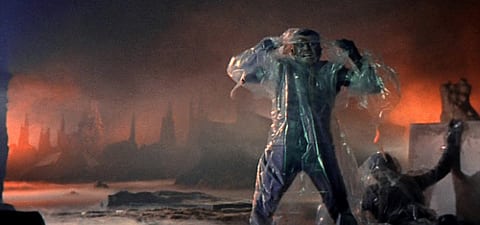
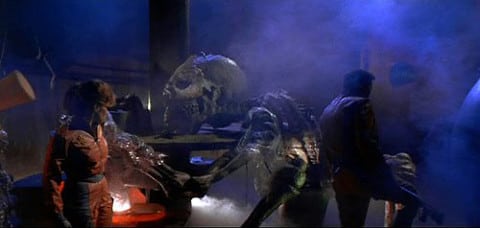



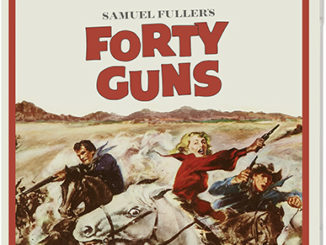

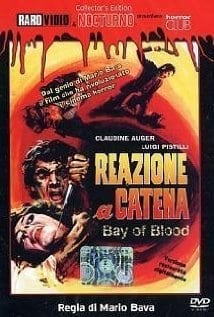
Be the first to comment